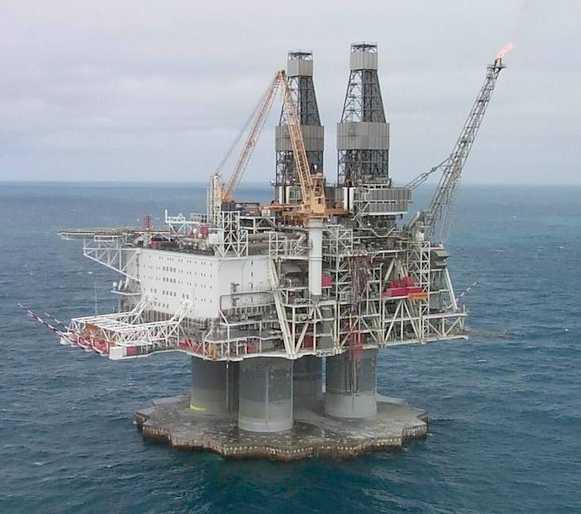India's Reliance Industries wants a hike in the price of natural gas to resume drilling in the KG-D6 fields, which have seen a sharp drop in output due to drilling of less wells than committed, investment research group Sanford C Bernstein & Co said.
"We believe that RIL doesn't believe it is worth its while to invest additional capital in drilling wells when the price at the beach remains at US$4.20" per million British thermal units, Neil Beveridge, a Hong Kong-based analyst for Bernstein, said in a report on Thursday.
Gas output from the Dhirubhai-1 and 3 fields in the KG-D6 block had steadily risen to 53 million standard cubic meters per day in March last year, but have dropped to below 42 mmscmd now instead of rising to the projected level of 61 mmscmd.
Another 8 mmscmd is produced from the MA field in the same block, taking the total output from KG-D6 to about 50 mmscmd.
The fall in output due to drilling of less wells had earned RIL the ire of the government and the regulator DGH.
While the DGH is pressing RIL to drill more wells outside the main channel that is currently producing, the government is pressuring RIL by directing it to supply gas to priority sectors like fertilizer and power and cut off sales to refineries and petrochemical plants, including its own.
"We believe that this is a proxy fight between the government and RIL," Bernstein Research said.
"Lower production output is primarily a function of the hiatus in development drilling," it said. "While it seems likely that the reservoir is more complex than originally anticipated, performance on a per well basis has not been too dissimilar to the original field development plan.
"Instead, the lower number of development wells drilled (18 versus 22 planned) is primarily the reason for the under-performance," it said.
Bernstein said completion of Phase - I drilling plus initiation of Phase-II drilling, when the total number of wells could reach up to 50, would restore output growth.
"We believe that the natural rate of the decline in production for the KG-D6 wells is around 20 percent annually, or around 5 percent per quarter, not substantially different from similar fields around the world," it said.
"In case RIL doesn't take any more action on the drilling of wells and connecting those to the reservoir and continues operating with 18 wells, we expect the production to reach a level of around 37-38 mmscmd by FY'2013," Bernstein said.
The government has asked the company to drill 11 wells by the fiscal-end to take the total number to 31 as had been planned when RIL won approval for investing $8.8 billion, S.K. Srivastava, the director general of the country's oil regulator, had said earlier this week.
RIL will submit a drilling plan in two weeks, he had said on May 2.
(C) 2011 Asia Pulse Pte Ltd.
"We believe that RIL doesn't believe it is worth its while to invest additional capital in drilling wells when the price at the beach remains at US$4.20" per million British thermal units, Neil Beveridge, a Hong Kong-based analyst for Bernstein, said in a report on Thursday.
Gas output from the Dhirubhai-1 and 3 fields in the KG-D6 block had steadily risen to 53 million standard cubic meters per day in March last year, but have dropped to below 42 mmscmd now instead of rising to the projected level of 61 mmscmd.
Another 8 mmscmd is produced from the MA field in the same block, taking the total output from KG-D6 to about 50 mmscmd.
The fall in output due to drilling of less wells had earned RIL the ire of the government and the regulator DGH.
While the DGH is pressing RIL to drill more wells outside the main channel that is currently producing, the government is pressuring RIL by directing it to supply gas to priority sectors like fertilizer and power and cut off sales to refineries and petrochemical plants, including its own.
"We believe that this is a proxy fight between the government and RIL," Bernstein Research said.
"Lower production output is primarily a function of the hiatus in development drilling," it said. "While it seems likely that the reservoir is more complex than originally anticipated, performance on a per well basis has not been too dissimilar to the original field development plan.
"Instead, the lower number of development wells drilled (18 versus 22 planned) is primarily the reason for the under-performance," it said.
Bernstein said completion of Phase - I drilling plus initiation of Phase-II drilling, when the total number of wells could reach up to 50, would restore output growth.
"We believe that the natural rate of the decline in production for the KG-D6 wells is around 20 percent annually, or around 5 percent per quarter, not substantially different from similar fields around the world," it said.
"In case RIL doesn't take any more action on the drilling of wells and connecting those to the reservoir and continues operating with 18 wells, we expect the production to reach a level of around 37-38 mmscmd by FY'2013," Bernstein said.
The government has asked the company to drill 11 wells by the fiscal-end to take the total number to 31 as had been planned when RIL won approval for investing $8.8 billion, S.K. Srivastava, the director general of the country's oil regulator, had said earlier this week.
RIL will submit a drilling plan in two weeks, he had said on May 2.
(C) 2011 Asia Pulse Pte Ltd.




No comments:
Post a Comment